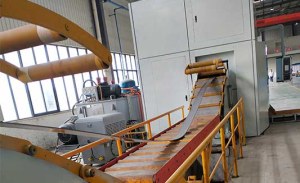BOYA fine blanking production division, the products are good stability and reliability, high degree of automation, high production efficiency, simple operation and ergonomic. For localization of high-end intelligent fine blanking equipment, raise the capacity of fine blanking production, After years of research and development, design and manufacturing, 320 tons, 630 tons, 700 tons of hydraulic fine blanking machines have been successful production and operation.
Types of Fine Blanking
Fine Blanking Line
Based on BOYA's excellent processing and manufacturing capacity and rich series of products, we have a complete set of fine blanking equipment for the fine blanking production line.
Fine Blanking Machine
BOYA series CNC hydraulic fine blanking machine developed by BOYA is high-end automation equipment with advanced technology, simple use, precision and independent intellectual property rights.
Blanking Machine Refabrication and Maintenance
As one of fine blanking suppliers, BOYA not only provides a full set of fine blanking production line equipment but also our technical team to provide comprehensive technical support and training services.
What is Fine Blanking?
Precision blanking. Including strong blanking precision blanking, precision blanking to concave die and flat blanking precision blanking. Automotive precision punching parts production to strong blanking precision blanking. The geometric shape, dimensional tolerance, shape and position tolerance and shear surface quality of fine blanking parts are much higher than ordinary blanking parts, fine blanking process plays a great role in the field of automotive parts manufacturing.
Working Principle of Fine Blanking
Compared to normal blanking, fine blanking operation is more precious, product high precision requirements, no collapse Angle, no burr, the full bright belt is the difficulty of stamping process, the use of ordinary blanking process cannot avoid burr, collapse angle.
Fine blanking technology is a special method to solve this kind of product.
Fine Blanking Advantages
Fine blanking is a kind of chipping-free processing technology, which is a precision blanking method developed from the general blanking technology. Fine blanking ensures that the punched surface of the punched part is free of cracks and tears over its entire material thickness. In addition, the tightest dimensional accuracy and flatness tolerances can be achieved. Fine blanking is able to obtain high quality fine blanked parts with higher dimensional accuracy, cleaner blanking surface, less warpage and better interchangeability than normal blanked parts in one punching stroke, and to achieve improved product quality at a lower cost.
Fine Blanking Process
There is a fundamental difference between the process characteristics of fine blanking and normal blanking. While normal blanking controls the tearing of the sheet during the blanking process, fine blanking does everything possible to inhibit the tearing of the sheet during the blanking process. Fine blanking design remains as one piece until the part is separated from the sheet, and the sheet metal is always in a plastic deformation process during fine blanking. To achieve this, the V-rim and counterpress are used to hold the sheet before punching to prevent the sheet from moving inside or outside during the punching process. In addition, together with the small gap between the convex and concave dies and the appropriate small rounded corners of the concave die, a three-way compressive stress state in the local area of the punching is formed during the punching process, thus ensuring the plastic deformation process of the punching. Moreover, the fine blanking material and lubrication state also have a great influence on the effect of fine blanking operation. The material with good plasticity, low deformation resistance, complete spheroidization, good dispersion and uniform distribution of fine spherical carbide organization is most suitable for fine blanking. A good lubricant not only improves the quality of the fine blanked parts, but also helps to reduce the wear of the die and improve the service life of the die. The fine blanking process requires precise punching force, crimping force and counter pressure of the fine blanking equipment.
Fine Blanking Applications
Fine blanking technology can be applied to various applications such as automobile, motorcycle, computer, video recorder, communication equipment, aircraft manufacturing, home appliances, office machinery, optical components, and construction industry etc. There are nearly 8000 kinds of parts produced by fine blanking, about 50%~60% of fine blanking parts are used in automobile industry, such as rack, tooth plate, cam on seat adjuster; ratchet, pawl, adjusting tooth plate, pull arm, push rod, web, support plate, etc. in brake system; lock plate, card plate, safety block, etc. in car lock; latch, inner gear ring, pawl, etc. in seat belt; follower plate, etc. in clutch; transmission Fork, etc.; transmission system flange, thrust gasket, etc.; door glass lifter gear plate, etc. Many of the stamped parts on these automobiles are produced by the fine blanking process. Boya is one of the leading fine blanking companies and suppliers in China and we can offer a complete fine blanking services and solutions to our customers.
Fine Blanking VS Stamping
Fine blanking originated from general stamping, but it is not simply an enhanced version of general stamping. The essential difference between the fine blanking process and the general blanking process is that the general blanking cannot effectively avoid the generation of tears in the section when punching, while the fine blanking tries to inhibit the occurrence of tears in the sheet material by all means when punching. The following are the differences between fine blanking and general stamping.
1. Difference in requirements of materials to be processed
Ordinary stamping can process almost any material, as long as the die steel is strong enough and the press pressure is sufficient.
However, the materials used for fine blanking require good plasticity, low flexural strength ratio and high elongation of the material to be processed because of the need to effectively transfer compressive stress between material crystals to inhibit cracking.
2. Differences in processing capacity characteristics
General punching limit size
Stamping: Minimum hole diameter of 1.5 times the material thickness.
Fine blanking: minimum hole diameter up to 0.6 times the material thickness.
Dimensional accuracy
Stamping: Normal dimensional accuracy, IT14.
Fine blanking: High dimensional accuracy, IT6~9.
Cold work hardening
Stamping: partial cold work hardening of section collapse and bright zone.
Fine blanking: cold hardening of the whole section, which can improve the strength of the contact surface. 4.
3. Difference in equipment used
Ordinary stamping equipment generally provides one-way power (there are also double power presses to process special-shaped products), i.e. punching force. However, fine blanking operation machines can provide three power forces, punching force, crimping force and counter-top force. And the fine blanking press is compact and has a small table surface. The table length of fine blanking machines of about 800T is generally about 1m. Of course, like ordinary stamping machines, fine blanking machines also need other supporting auxiliary equipment. The necessary auxiliary systems for general fine blanking machines are uncoiling and leveling feeder, die lubrication system and parts waste separation system.
If you want to know more about coil processing lines, please visit our website.
We also have types of ctl machine for sale, more details, please leave us a message.
Location : NO.3 Tianlai Road, Auto Industrial Park, Hi-Tech Zone, Xiangyang, Hubei, China, 441004 Hi-Tech,
Contact : chinery boyama, 0710 3273725








